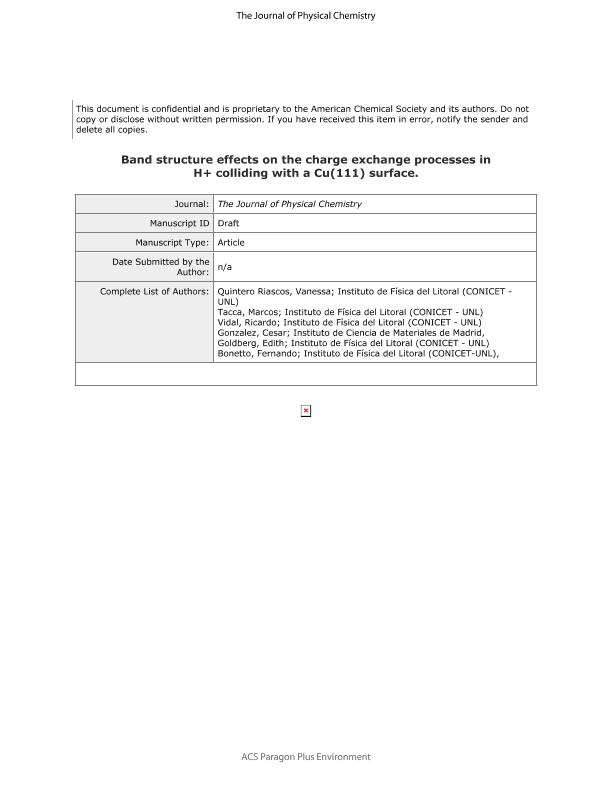Mostrar el registro sencillo del ítem
dc.contributor.author
Quintero Riascos, Vanessa Alexandra

dc.contributor.author
Tacca, Marcos Sebastian

dc.contributor.author
Vidal, Ricardo Alberto

dc.contributor.author
Gonzalez, C.
dc.contributor.author
Goldberg, Edith Catalina

dc.contributor.author
Bonetto, Fernando Jose

dc.date.available
2019-10-15T14:16:22Z
dc.date.issued
2018-12
dc.identifier.citation
Quintero Riascos, Vanessa Alexandra; Tacca, Marcos Sebastian; Vidal, Ricardo Alberto; Gonzalez, C.; Goldberg, Edith Catalina; et al.; Band Structure Effects on the Charge Exchange Processes in H+ Colliding with a Cu(111) Surface; American Chemical Society; Journal of Physical Chemistry C; 122; 49; 12-2018; 28192-28203
dc.identifier.issn
1932-7447
dc.identifier.uri
http://hdl.handle.net/11336/85879
dc.description.abstract
The low-energy ion scattering (LEIS) technique was used to experimentally determine the formation of positive and negative ions in the scattering of protons by a Cu(111) surface for a large scattering angle in the backscattering configuration and a wide range of incoming energies (2-8 keV). Two different collisional geometries were analyzed for a 135° fixed scattering angle: 45°/90° and 67.5°/67.5° incoming/exit angles measured with respect to the target surface. The total fraction of backscattered ions ranges from 10% to 25%, and a peculiarly high yield of negative ions, which always exceeds that of positive ions, was detected for the whole energy range analyzed. A strong dependence of the measured ion fractions with the geometrical conditions was experimentally found. On the theoretical side, a first-principles quantum-mechanical formalism that takes into account the three possible final charge states of the H+ in a correlated way and the fine details of the band structure of the Cu(111) surface was applied to describe the charge transfer processes involved in the experimental situation. The theoretical calculation leads to a nonmonotonous dependence with the incoming energy that properly describes the experimental results, especially the negative ion fraction in the specular collisional geometry. The oscillatory behavior predicted by the theory in the range of low energies is clear evidence of the charge exchange between localized states, that is, the situation related with the presence of the surface state immersed in the L-gap present in the Cu(111) surface. The positive ion fraction is discussed for the first time for this collisional system. The differences found between the measurements and the theory seem to indicate that the neutralization to excited states and also the formation of excited negative hydrogen ions are possible charge exchange channels in the dynamic process analyzed.
dc.format
application/pdf
dc.language.iso
eng
dc.publisher
American Chemical Society

dc.rights
info:eu-repo/semantics/openAccess
dc.rights.uri
https://creativecommons.org/licenses/by-nc-sa/2.5/ar/
dc.subject
Charge Exchange
dc.subject
LEIS
dc.subject
H/Cu(111)
dc.subject.classification
Física Atómica, Molecular y Química

dc.subject.classification
Ciencias Físicas

dc.subject.classification
CIENCIAS NATURALES Y EXACTAS

dc.title
Band Structure Effects on the Charge Exchange Processes in H+ Colliding with a Cu(111) Surface
dc.type
info:eu-repo/semantics/article
dc.type
info:ar-repo/semantics/artículo
dc.type
info:eu-repo/semantics/publishedVersion
dc.date.updated
2019-10-10T14:58:03Z
dc.journal.volume
122
dc.journal.number
49
dc.journal.pagination
28192-28203
dc.journal.pais
Estados Unidos

dc.description.fil
Fil: Quintero Riascos, Vanessa Alexandra. Consejo Nacional de Investigaciones Científicas y Técnicas. Centro Científico Tecnológico Conicet - Santa Fe. Instituto de Física del Litoral. Universidad Nacional del Litoral. Instituto de Física del Litoral; Argentina
dc.description.fil
Fil: Tacca, Marcos Sebastian. Consejo Nacional de Investigaciones Científicas y Técnicas. Centro Científico Tecnológico Conicet - Santa Fe. Instituto de Física del Litoral. Universidad Nacional del Litoral. Instituto de Física del Litoral; Argentina
dc.description.fil
Fil: Vidal, Ricardo Alberto. Consejo Nacional de Investigaciones Científicas y Técnicas. Centro Científico Tecnológico Conicet - Santa Fe. Instituto de Física del Litoral. Universidad Nacional del Litoral. Instituto de Física del Litoral; Argentina
dc.description.fil
Fil: Gonzalez, C.. Universidad Autónoma de Madrid; España
dc.description.fil
Fil: Goldberg, Edith Catalina. Consejo Nacional de Investigaciones Científicas y Técnicas. Centro Científico Tecnológico Conicet - Santa Fe. Instituto de Física del Litoral. Universidad Nacional del Litoral. Instituto de Física del Litoral; Argentina
dc.description.fil
Fil: Bonetto, Fernando Jose. Consejo Nacional de Investigaciones Científicas y Técnicas. Centro Científico Tecnológico Conicet - Santa Fe. Instituto de Física del Litoral. Universidad Nacional del Litoral. Instituto de Física del Litoral; Argentina
dc.journal.title
Journal of Physical Chemistry C

dc.relation.alternativeid
info:eu-repo/semantics/altIdentifier/url/https://pubs.acs.org/doi/10.1021/acs.jpcc.8b09828
dc.relation.alternativeid
info:eu-repo/semantics/altIdentifier/doi/http://dx.doi.org/10.1021/acs.jpcc.8b09828
Archivos asociados
